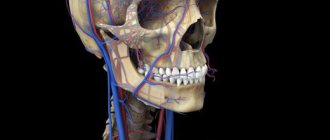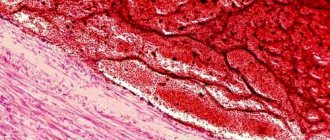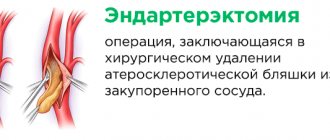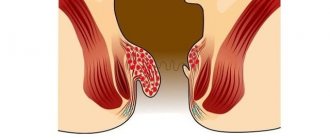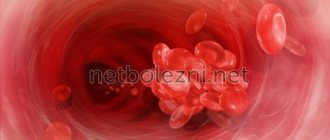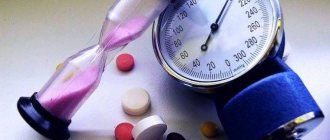Cleaning blood vessels from cholesterol is a popular topic among those who care about their health. After all, angina pectoris and myocardial infarction, impaired blood supply to the brain and stroke, intermittent claudication, erectile dysfunction and other problems arise due to “clogging” of blood vessels with cholesterol.
It would be wonderful to return the blood vessels to their original state and get rid of diseases, but the human body is more complex. The deposition of cholesterol in blood vessels - atherosclerosis - is not just their “clogging”, but a complex long-term process.
Fat metabolism disorders
Lipids (fats) in the bloodstream are connected to proteins, that is, they move in the blood as part of protein-lipid complexes:
- VLDL – very low density lipoproteins;
- LDL – low density lipoproteins;
- DILP – intermediate density lipoproteins;
- HDL is high density lipoprotein.
Without cholesterol, a person could not exist. Its main meaning:
- Adrenal hormones (cortisol), male and female sex hormones (for example, testosterone and estradiol) are synthesized from cholesterol.
- Cholesterol is involved in the synthesis of bile acids necessary for digestion.
- Cholesterol is part of the membranes of all cells in the body.
And excess cholesterol from food does not always lead to the development of atherosclerosis . The disease is based on a disorder of lipid metabolism, in which there is more “bad” cholesterol (VLDL and LDL), and less “good” cholesterol (HDL).
Diet food
The diet consists of limiting foods containing cholesterol: animal fats, fatty meats and offal, eggs, canned food, chocolate products, and high-fat dairy products.
It is necessary to eat foods rich in iodine, vitamin B, and ascorbic acid, for example:
- seaweed,
- vegetable oils rich in omega 3,
- beans,
- zucchini,
- eggplants,
- cauliflower and broccoli,
- berries with nuts,
- dried fruits,
- citrus,
- watermelon.
For drinks you should choose green tea, freshly squeezed juices, and pure spring water. The patient is required to reduce the amount of salt and sugar, eliminate alcohol and cigarettes.
How does atherosclerosis progress?
If there is a lot of VLDL or LDL in the blood, then they penetrate into the inner layer of the aorta and arteries. High blood pressure (hypertension) damages the wall of blood vessels, promoting the deposition of lipids in it. First, lipids form fatty spots or streaks. They appear first of all on the posterior wall of the aorta and at the origin of its branches.
There is an interesting phenomenon: 50% of children under 1 year of age have lipid stains in the aorta. In adolescence, they even appear in the coronary arteries of the heart. But with age, these phenomena usually go away.
In atherosclerosis, cholesterol deposits form atheromatous plaques. Next, connective tissue grows into this formation, forming a fibrous plaque. Often fibrous plaques merge with each other and greatly narrow the lumen of the vessel. Even later, they are impregnated with calcium salts.
Consequences of atherosclerosis
If atherosclerosis is left unattended, it can lead to the following events:
- Lack of oxygen and vital substances to an organ or part of the body.
- Plaque destruction.
- Formation of a blood clot at the site of a destroyed plaque.
- If a blood clot and/or the contents of a disintegrated plaque clogs the lumen of an artery, part of one or another organ will die due to a disruption in the blood supply. This is a heart attack (ischemic stroke) or gangrene.
- It is possible for the vessel to expand - an aortic aneurysm - with subsequent dissection and rupture of its wall.
In different people, atherosclerosis damages different regions of the blood supply, so there are several forms of atherosclerosis and its likely consequences:
| Form of atherosclerosis | Consequences |
| Atherosclerosis of the thoracic and abdominal aorta and their branches | Intermittent claudication, increased risk of aortic aneurysm |
| Atherosclerosis of the coronary arteries | Coronary heart disease, myocardial infarction |
| Atherosclerosis of cerebral vessels | Brain disorders, stroke |
| Atherosclerosis of peripheral arteries | Gangrene of the intestine, insufficient blood supply to the extremities, intermittent claudication |
| Atherosclerosis of the renal arteries | Poorly controlled arterial hypertension (180/90 mm Hg or higher). Chronic renal failure |
Ways to combat atherosclerosis
Nowadays, it is possible to effectively combat this disease. Therapy should be varied, combine several methods for treatment. Do not neglect traditional medicine.
Medication
Tablets for cleansing blood vessels mainly affect fat metabolism and normalize the balance between “bad” and “good” cholesterol. But only a doctor understands which pills are suitable for whom and how to use them.
Statins
These are the most popular medications for correcting fat metabolism and cleaning blood vessels from cholesterol. Statins block the main enzyme that synthesizes cholesterol in the body. This causes liver cells to take more LDL from the blood, lowering its levels.
Statins also improve the function of the inner layer of blood vessels - the endothelium, prevent the formation of blood clots, and slow down the transition of plaque from lipid to fibrous.
Monitoring by a doctor is needed because in very rare cases statins cause muscle damage. After prescribing statins, after some time (3 months), control of transaminases (AST, ALT) is prescribed. Then the dosage is left the same, adjusted or the drug is discontinued.
Fibrates
Reduce the level of “bad” cholesterol and increase the level of “good” cholesterol. But in rare cases, they also have a negative effect on the muscles and liver, so taking fibrates should be under medical supervision.
A nicotinic acid
Reduces VLDL synthesis in the liver, increases HDL levels. But often this drug is poorly tolerated, so careful dosage selection is required. There is also a risk of acute liver failure while taking nicotinic acid, so the doctor periodically prescribes a study of the levels of ALT, AST, and GGTP.
Bile acid sequestrants
Now they are not used in Russia.
Ezetimibe
Slows down the absorption of dietary cholesterol in the intestines.
Polyunsaturated omega-3 fatty acids
Pharmacies sell dietary supplements of varying quality. Doctors prescribe really effective omega-3 fatty acid supplements.
Injections of nanofibers that reduce atherosclerotic plaque are being developed.
Cleansing blood vessels from cholesterol with medications is carried out as prescribed and under the supervision of a doctor. Different medications are suitable for different people, and self-medication can have serious consequences!
Surgical
If drug cleansing of blood vessels does not help prevent myocardial infarction, reduce the risk of stroke and other serious complications, they move on to surgical treatment.
There is an operation to remove atherosclerotic plaque from the carotid artery - endarterectomy. But more often surgical treatment is aimed at restoring the blood supply to the organ. There are different methods: expanding the lumen of the vessel, removing the damaged artery and replacing it, creating additional blood flow to the affected organ.
All these operations are carried out according to strict indications, when there is really a need for them.
Folk
In Russia they are very fond of “traditional” medicine and the so-called “treatment at home”. Although a healthy lifestyle seems to be more effective than traditional methods. It does the same thing as herbs and their decoctions for cleaning blood vessels from cholesterol.
For example, garlic has an antioxidant effect and reduces the amount of lipids in the blood. But it is not a panacea and can be included in the diet. Flax oil is one of a number of vegetable oils containing unsaturated fatty acids.
Homeopathic remedies, soda and other alternative and folk medicine have not proven their benefits in the treatment of atherosclerosis, hypertension and other diseases.
Atherosclerosis is a long-term and permanent process. You also need to fight it constantly. Therefore, there is no point in eating improperly and then cleaning the vessels only with folk remedies.
Lifestyle change
Lifestyle changes can effectively stop or slow atherosclerosis in some people.
Diet
It is recommended to eat more fresh vegetables and fruits, nuts, wholemeal bread, cereals, low-fat dairy products, lean meats, fish (especially fatty sea fish).
Fats
There are different types of fats. Much attention is paid to fatty acids in the diet.
Main types of fatty acids:
| Fatty acid type | Where are they kept? |
| Saturated | animal fats, palm and coconut oil |
| Monounsaturated | olive, rapeseed, soybean and sunflower oils |
| Polyunsaturated. The most beneficial are omega-3 and omega-6 fatty acids | corn, sunflower and flaxseed oils, omega-3 fatty acids in flaxseed oil, fish oil and fatty fish |
The amount of omega-3 fatty acids should be greater than omega-6.
Omega-6 fatty acids are found in many vegetable oils, raw nuts and seeds - pistachios, pine nuts, sunflower seeds, sesame seeds, pumpkin. They are also found in butter, animal fat, poultry, red meat and eggs. Preference is given to products containing omega-3 fatty acids. Fish from the northern seas contains a lot of omega-3 fatty acids . It is recommended to consume sea fish 2 times a week, and 1 time - fatty fish.
The most harmful are trans-isomers of fatty acids, which are found in hard margarines, chips, and biscuits. They increase the level of “bad” cholesterol and reduce the level of “good” cholesterol.
An egg contains 186 mg of cholesterol, but total cholesterol responds differently to dietary cholesterol in different people. On the other hand, eggs increase levels of “good” cholesterol (HDL). Moreover, eggs contain vitamins and antioxidants (lutein, zeaxanthin), which are especially useful for diseases of the retina and lens.
People with high cholesterol and risk of cardiovascular disease are recommended to consume up to 2 – 3 eggs (egg yolks) per week.
Carbohydrates
| Simple carbohydrates | Glucose, fructose, sucrose, lactose | Fruits, vegetables, sweet desserts | |
| Complex carbohydrates | Digestible | Starch | Whole grains, Potatoes |
| Glycogen | Meat | ||
| Indigestible (dietary fiber) | Soluble (pectins) | Legumes | |
| Insoluble (cellulose, hemicellulose) | Legumes, bran, whole grains. |
It is recommended to consume more than 500 g of fruits and vegetables per day (except potatoes). Plant foods slow down the absorption of cholesterol from the intestines.
Carbohydrates found in sugary desserts and drinks lower “good” cholesterol (HDL) levels. A person engaged in mental or light physical work can consume 30 grams of additional sugar per day (6 lumps of sugar or 150 grams of sweet desserts).
Dietary fiber inhibits absorption and accelerates the elimination of cholesterol and toxic substances. Dietary fiber is found in grains, legumes, as well as berries and dried fruits. It is better to choose bread and cereals made from whole grains.
Salt
Limiting the amount of table salt reduces blood pressure by several millimeters of mercury. The salt content in the diet should not exceed 5 grams per day. That is, it is recommended to under-salt food and limit the consumption of sausages, smoked meats, pickles, and chips.
Physical activity
The nature of regular physical activity is selected taking into account the patient’s age, state of the cardiovascular system, musculoskeletal system and other systems.
Healthy people are recommended to engage in moderate aerobic physical activity (at least 30 minutes a day, 5 days a week) or vigorous physical activity (at least 15 minutes a day, 5 days a week), as well as a combination of exercise intensities. It is recommended to gradually increase moderate aerobic activity to 300 minutes per week or intense aerobic activity to 150 minutes per week.
Aerobic activity is walking, cycling, dancing, skiing, skating, rowing or swimming.
Weight loss
Proper nutrition and adequate physical activity gradually and safely reduce body weight to an optimal level.
The following indicators are used as reference points: body mass index (BMI) and waist circumference. BMI is calculated using the formula: BMI = weight (kg)/height (m)2. Normal BMI is 18.5 – 24.9 kg/m2.
Waist circumference in men should be no more than 94 cm, in women - 80 cm. An increase in waist circumference in men by more than 102 cm, in women by more than 88 cm is an indicator of abdominal obesity.
If the optimal BMI cannot be achieved, then it is recommended to reduce body weight by at least 10%.
Folk remedies for cholesterol in blood vessels
Folk remedies can sometimes work wonders, but it should be remembered that the gifts of nature have certain specifics.
Infusions, decoctions, tinctures, oil extracts only work if taken regularly over a long period of time (there are some exceptions).
Below are several healthy recipes that have been tested by many dozens of people.
Folk remedy - dandelion roots. Medicinal properties
Dandelion root is stored in early spring or late autumn - during these periods they are full of useful substances. In summer you can drink a drink made from fresh roots.
- Collect at the rate of 2-3 roots per mug of coffee. It is recommended to dig up the roots so as not to leave half in the ground.
- The root is cleaned of leaves and soil, rinsed with water and cut into pieces about 1 cm long.
- Heat a clean, dry frying pan over a fire, pour in the roots and dry with stirring.
- When the product turns chocolate color and stops sizzling, it is ready.
- Measure according to the desired volume of the drink and pour into cold water.
- The drink is ready when the roots sink to the bottom in boiling water and the liquid becomes dark like coffee.
- Let it sit for a few minutes and you are ready to drink.
Slightly sweet taste, pleasant drink, can replace coffee, plus it’s healthy.
Cleansing blood vessels, Garlic, lemon, ginger
An effective way to tidy up your blood vessels is a remedy made from three wonderful healthy products.
To prevent blood vessel cleaning from being a difficult procedure, you can add a refreshing drink to your diet - almost a mojito.
Buy:
- lemons – 15-16 pieces
- garlic – 15-16 heads
- ginger 200 g.
Peel the ginger and garlic and crush into porridge. You can use a blender. Cut the lemons into cubes along with the peel.
Pour everything prepared and pour it into a three-liter jar. Top up with cold boiled water. Leave at room temperature for 3 days. Then the drink is filtered and you can drink it - 150 g daily - that’s less than half a glass. Drink before meals. Raw materials are used once. For the next portion of the healing drink, everything is bought anew.
It is recommended to drink at least 2 liters of water during the day. For variety, drinking the drink can be interspersed with eating medicinal sweets made from the same ingredients.
Sweets
Need to buy:
- 5 lemons
- 3 cloves garlic
- 100 g ginger
- 300 g honey.
Grind the vegetable ingredients in a meat grinder. Pour the resulting mixture with honey (if the honey is hard, heat it in a water bath). Stir and place in an ice dispenser.
Place in the freezer, take it out after a day, shake it out of the dispenser and store it in the refrigerator.
You can eat several lozenges a day.
Alcohol and smoking
The risk of developing atherosclerosis and myocardial infarction when smoking increases by 1.5 to 6 times.
Smokers are 8 times more likely to develop atherosclerotic aortic aneurysm. Nicotine and carbon monoxide damage the endothelium. In people who quit smoking, the number and diameter of capillaries increases. This means that organ nutrition improves. Small doses of alcohol reduce the risk of developing cardiovascular disease . For example, vodka, cognac, whiskey - no more than 45 - 50 ml; red or white table wine – no more than 150 ml. This is the maximum safe single consumption of alcohol in one day.
In countries where red wine is popular, mortality from cardiovascular diseases is lower than in cultures where spirits are preferred.
Systematic alcohol consumption is a risk factor for the development of atherosclerosis. If a person has ever been treated for alcoholism or drug addiction, if he has blood relatives who are or have been ill with alcoholism or drug addiction, then it is better for him to give up alcohol altogether.
If lifestyle changes do not help cope with atherosclerosis, then medications are prescribed that effectively clean the blood vessels.
Why do cholesterol plaques occur?
Not everyone is at risk of blocking blood vessels with atherosclerotic plaques, but many are at risk.
According to statistics, cholesterol with its increased content is found in the blood serum of 10% of the world's population.
Preventive and healing cleansing of the bloodstream using natural remedies has become very popular. But for awareness, it is important to understand the causes of unfavorable preconditions for the development of atherosclerosis.
It is difficult and sometimes impossible for medicine to eliminate the predisposition to this disease inherent in human genes. The age factor is also strongly influenced, indicating the presence of a risk group among people over 45 years old.
But it is also true that cholesterol can be regulated by diet . By normalizing lifestyle, weight, and getting rid of some bad habits, a person achieves an improvement in the condition of the body.
Asking the question: how to clean blood vessels from cholesterol plaques and blood clots, the patient should consider ways to improve the quality of health.
For example, the following harmful factors can be excluded:
- Alcohol, smoking, other bad habits.
- Low mobility.
- Fatty foods reduce the function of hormones that regulate metabolic processes. The same applies to “heavy” foods.
- Cholesterol is deposited against the background of diseases: diabetes, increased weight, metabolic disorders, hormonal disorders, arterial hypertension.
- Stressful situations that interfere with a healthy lifestyle.
Conclusion: diet and elimination of bad habits play a very significant role.
